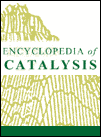Isotope Methods in Catalysis – Biological
Abstract
Isotopic methods in the study of biocatalysis are chiefly used to characterize the mechanisms by which enzymes catalyze their target reactions. The techniques in use include tracer methods, by which the positions of individual atoms in a starting molecule are traced in downstream intermediates or products; exchange methods, in which isotopic mixing between distinct pools such as the solvent and enzyme-bound intermediates is measured in order to test mechanistic hypotheses; and kinetic isotope effects, in which the relative rates of reaction of different isotopes of the same element are measured to identify rate-limiting steps and determine transition-state structures and other mechanistic information. Tracer and exchange methods are illustrated but, not being subject to easy generalization, are not treated in detail. The bulk of the article is devoted to kinetic isotope effects in the study of biocatalysts.
Bibliography
- 1
S. Ainsworth,
Steady-State Enzyme Kinetics,
University Park Press,
Baltimore,
1977.
10.1007/978-1-349-01959-5 Google Scholar
- 2 M. Sinnott, ed. Comprehensive Biological Catalysis: A Mechanistic Reference, vols. I–IV, Academic Press, London, 1998.
- 3 A. Radzicka and R. Wolfenden, Science 267, 90–93 (1995).
- 4 F. H. Westheimer, Adv. Phys. Org. Chem. 21, 1–35 (1985), and references therein.
- 5 R. L. Schowen and K. B. Schowen, in E. Wada, T. Yoneyama, M. Minagawa, and T. Ando, eds., Stable Isotopes in the Biosphere, Kyoto University Press, Kyoto, 1993.
- 6 D. W. Parkin, in P. F. Cook, ed., Enzyme Mechanisms from Isotope Effects, CRC Press, Boca Raton, Fla., 1991, pp. 269–290.
- 7 L. B. Sims and D. E. Lewis, Isotopes Org. Chem. 6, 161–259 (1984).
- 8 M. E. Tanner and G. L. Kenyon, in M. Sinnott, ed., Comprehensive Biological Catalysis, Vol. II, Academic Press, London, 1998, pp. 7–41.
- 9 G. J. Cardinale and R. H. Abeles, Biochemistry 7, 3970–3978 (1968).
- 10 L. M. Fisher, J. G. Belasco, T. W. Bruice, W. J. Albery, and J. R. Knowles Biochemistry 25, 2543–2551 (1986).
- 11 D. B. Northrop, Annu. Rev. Biochem. 50, 103–131 (1981).
- 12 W. J. Albery and J. R. Knowles, J. Am. Chem. Soc. 99, 637–638 (1977).
- 13 W. P. Huskey and R. L. Schowen, J. Am. Chem. Soc. 105, 5704 (1983).
- 14 W. P. Huskey, J. Phys. Org. Chem. 4, 361–366 (1991).
- 15 C. Alhambra, J. Gao, J. C. Corchado, J. Villa, and D. G. Truhlar, J. Am. Chem. Soc. 121, 2253–2258 (1999).
- 16 J. K. Chin and J. K. Klinman, Biochemistry 39, 1278–1284 (2000).
- 17 J. Basran, M. J. Sutcliffe, and N. S. Scrutton, Biochemistry 38, 3218–3222 (1999).
- 18 L. I. Krishtalik, Biochim. Biophys. Acta 1458, 6–27 (2000).
- 19
K. B. Schowen and
R. L. Schowen,
Meth. Ezymol.
87C,
551
(1982).
10.1016/S0076-6879(82)87031-6 Google Scholar
- 20 D. M. Quinn and L. D. Sutton, in P. F. Cook, ed., Enzyme Mechanisms from Isotope Effects, CRC Press, Boca Raton, Fla., 1991, pp. 73–126.
- 21 M. A. Rishavy and W. W. Cleland, Can. J. Chem. 77, 967–977 (1999).
- 22 R. Eliason and M. M. Kreevoy, J. Am. Chem. Soc. 100, 7037–7041 (1978).
- 23 C. G. Swain, D. A. Kuhn, and R. L. Schowen, J. Am. Chem. Soc. 87, 1553 (1965).
- 24 E. H. Cordes, Prog. Phys. Org. Chem. 4, 1–44 (1967).
- 25 R. L. Schowen, Mechanistic deductions from solvent isotope effects. Prog. Phys. Org. Chem. 9, 275–332 (1972).
- 26 K. B. Schowen, H.-H. Limbach, G. S. Denisov, and R. L. Schowen, Biochim. Biophys. Acta 1458, 43–62 (2000).
- 27 R. L. Schowen, in J. F. Liebman and A. Greenberg, eds., Mechanistic Principles of Enzyme Activity, VCH Publishers, New York, 1988, pp. 119–168.
- 28 K. S. Venkatasubban and R. L. Schowen, Crit. Rev. Biochem. 17, 1–44 (1984).
- 29 F. J. Alvarez and R. L. Schowen, Isotopes Org. Chem. 7, 1–60 (1987).
- 30 R. L. Schowen, in M. Sinnott, ed., Comprehensive Biological Catalysis, Vol. 2, Academic Press, London, 1998, pp. 217–266.
- 31 R. H. Hoff, A. C. Hengge, L. Wu, Y.-F. Keng, and Z.-Y. Zhong, Biochemistry 39, 46–54 (2000).
- 32 V. L. Schramm, Annu. Rev. Biochem. 67, 693–720 (1998).
- 33 D. A. Singleton and M. J. Szymanski, J. Am. Chem. Soc. 121, 9455–9456 (1999).
General References
- T. C. Bruice and S. J. Benkovic, Bioorganic Mechanisms, vols. 2, W.A. Benjamin, New York, 1966.
- J. Bigeleisen and M. Wolfsberg, Adv. Chem. Phys. 1, 15 (1958).
-
R. P. Bell,
The Tunnel Effect in Chemistry,
Chapman and Hall,
London,
1980.
10.1007/978-1-4899-2891-7 Google Scholar
- W. W. Cleland, M. H. O'Leary, and D. B. Northrop, eds., Isotope Effects on Enzyme-Catalyzed Reactions, University Park Press, Baltimore, 1977.
- C. J. Collins and N. S. Bowman, Isotope Effects in Chemical Reactions, Van Nostrand Reinhold, New York, 1970.
- P. F. Cook, ed., Enzyme Mechanisms from Isotope Effects, CRC Press, Boca Raton, Fla., 1991.
- A. Fersht, Structure and Mechanism in Protein Science: A Guide to Enzyme Catalysis and Protein Folding, W.H. Freeman, New York, 1999.
-
R. D. Gandour and
R. L. Schowen, eds.,
Transition States of Biochemical Processes,
Plenum Press,
New York,
1978.
10.1007/978-1-4684-9978-0 Google Scholar
- W. P. Jencks, Catalysis in Chemistry and Enzymology, McGraw-Hill, New York, 1969.
- A. Kohen and J. P. Klinman, Chem. Biol. 6, R191–R198 (1999).
- L. Melander and W. H. Saunders Jr., Reaction Rates of Isotopic Molecules, John Wiley & Sons, Inc., New York, 1980.
- M. Page and A. Williams, Organic & Bio-Organic Mechanisms, Addison Wesley Longman, Essex, U.K., 1997.
- D. V. Roberts, Enzyme Kinetics, Cambridge University Press, Cambridge, 1977.
- K. B. Schowen and R. L. Schowen, Bioscience 31, 826 (1982).
- M. J. Sutcliffe and N. S. Scrutton, Trends Biochem. Sci. 25, 405–408 (2000).
- K. S. Venkatasubban and R. L. Schowen, Crit. Rev. Biochem. 17, 1 (1984).



